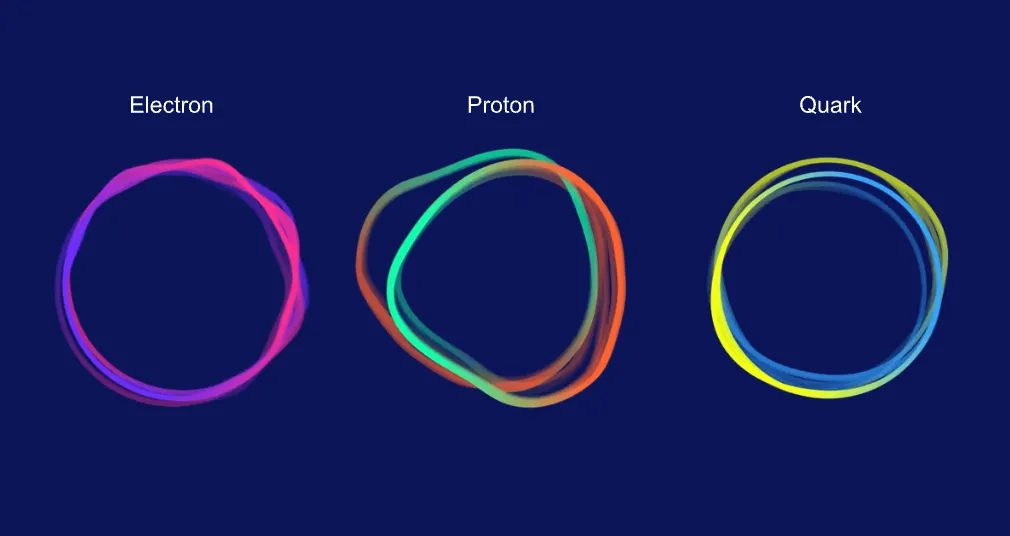What is String Theory?

“The unreasonable effectiveness of mathematics in the natural sciences is a wonderful gift which we neither understand nor deserve.”— Eugene Wigner
Overview
String theory challenges our understanding of the world and inspires a deeper appreciation for the intricate connections between mathematics and physics. It’s a theoretical framework that unifies the fundamental forces—gravity, electromagnetism, the weak nuclear force, and the strong nuclear force. At its core, string theory posits that the fundamental building blocks of the universe are not point-like particles, as traditionally thought, but rather tiny, vibrating strings. These strings can oscillate in different modes, with each mode corresponding to a different particle, giving rise to the rich tapestry of matter and forces that govern our universe.
What is String Theory?
String theory is a theoretical framework in physics that proposes that the fundamental building blocks of the universe are not point-like particles, as traditionally believed, but rather tiny, one-dimensional strings. These strings can vibrate in different modes, and each mode corresponds to a different particle, thereby unifying the diverse range of particles and forces in nature.
For a visual explanation watch this amazing video of Brian Greene, a professor of Mathematics and Physics at Columbia University:
Developed in the late 20th century, string theory seeks to reconcile the fundamental forces of nature—gravity, electromagnetism, and the strong and weak nuclear forces—within a single cohesive model. This unification is a significant goal in physics, often referred to as the “theory of everything.” String theory hypothesizes additional dimensions beyond the familiar three of space and one of time; typically, it suggests the existence of up to ten or eleven dimensions. These extra dimensions are theorized to be compactified or curled up in ways that are not immediately observable.
One of the most captivating aspects of string theory is its mathematical elegance. The equations and symmetries that emerge from this framework often exhibit a level of beauty that resonates with physicists and mathematicians alike. However, string theory faces significant challenges, particularly in terms of experimental validation. Many of its predictions are currently beyond the reach of direct testing, leading to debates about its status as a scientific theory.
Despite these challenges, string theory remains a vibrant area of research, inspiring new ideas in physics, cosmology, and beyond. It invites us to rethink the fundamental nature of reality and encourages interdisciplinary exploration, bridging gaps between various fields of science and philosophy. Through this exploration, string theory broaden our understanding of the universe and highlights the intricate connections between mathematics and the physical world.
Aesthetic appeal of String Theory
The beauty of string theory lies in its profound mathematical elegance and its ability to unify complex concepts within a simple framework. String theory posits that the fundamental components of the universe are not point-like particles but tiny, vibrating strings. One of the most striking aspects of string theory is its intricate mathematics. The equations governing string dynamics reveal beautiful symmetries and structures, such as Calabi-Yau manifolds, which describe how extra dimensions may be compactified. These mathematical structures not only provide solutions to complex problems but also resonate with a sense of beauty that many physicists find compelling.
String theory’s unification of forces—from gravity to electromagnetism—adds to its aesthetic allure. It presents a vision of the universe where seemingly disparate forces are interconnected, reflecting an underlying harmony in nature. This idea echoes philosophical notions of beauty, where simplicity and symmetry often signal deeper truths.
The aesthetic appeal of string theory is not merely in its scientific implications but also in its ability to inspire wonder and curiosity about the universe. It encourages us to appreciate the elegance that can emerge from the complex interplay of fundamental forces, illuminating the intricate connections that define our reality.
Philosophical Implications
String theory challenges our understanding of the basic component of universe. String theory proposes that tiny, vibrating strings are the fundamental building blocks rather than point-like particles. This shift prompts questions on our mind about the essence of matter and the nature of reality itself, suggesting that our perception may be limited or misleading.
The introduction of extra dimensions beyond the familiar three of space and one of time tasks a reevaluation of our metaphysical views. It raises intriguing questions about existence in higher dimensions and the implications for causality and simultaneity, pushing the boundaries of how we conceptualize the universe.
String theory’s goal of unifying all fundamental forces resonates with philosophical ideals of harmony and interconnectedness. This pursuit suggests that seemingly disparate phenomena may share a common origin, aligning with the quest for overarching truths in nature.
Criticisms and Challenges
One of the primary criticisms of string theory is its lack of direct experimental validation. Many predictions made by string theory are currently beyond the reach of experimental testing. This raises questions about its status as a scientific theory, as empirical verification is a cornerstone of the scientific method.
String theory can be highly complex, involving sophisticated mathematics that can lead to a multitude of possible solutions, known as “vacua.” This complexity raises concerns about overfitting, where the theory can accommodate a wide range of scenarios without making definitive predictions. Critics argue this makes it difficult to determine which, if any, vacua correspond to our physical universe.
Some interpretations of string theory suggest the existence of a multiverse, where numerous universes with different physical laws coexist. This concept has been criticized for being speculative and lacking empirical support, leading to debates about its scientific legitimacy.
The scientific community is divided on the merits of string theory. While some researchers view it as a promising avenue for unification in physics, others advocate for alternative approaches, such as loop quantum gravity, leading to ongoing debates about the future direction of theoretical physics.
Conclusion
String theory represents a groundbreaking framework that seeks to unify the fundamental forces of nature through its elegant mathematical structures. By positing that the universe’s basic components are tiny, vibrating strings, it offers insights into complex phenomena like black holes and the nature of dark matter. Despite ongoing criticisms regarding its lack of experimental validation, string theory stimulates interdisciplinary dialogue among physicists, mathematicians, and philosophers. As researchers pursue its implications for our understanding of spacetime and the cosmos, string theory not only enriches our grasp of reality but also inspires future generations to explore the intricate beauty of the universe.


